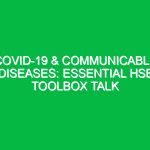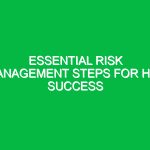Introduction
Risk management methods are critical for organizations striving to maintain health, safety, and environmental (HSE) standards. In today’s ever-evolving landscape, where industries face numerous Hazards and environmental challenges, these methods serve as a cornerstone for mitigating risks. By systematically identifying, evaluating, and controlling potential Hazards, organizations can protect their workforce, enhance Safety Procedures, and uphold environmental integrity. This article explores the essential risk management methods pertinent to the HSE domain, offering insights, best practices, and real-world examples to illustrate their importance.
Understanding Risk Management Methods in HSE
Risk management methods encompass a range of strategies and practices designed to minimize the likelihood of adverse events. In the context of HSE, these methods are tailored to address specific risks associated with Workplace Safety and environmental protection. Key components of effective risk management include risk assessment, risk control, and risk communication.
Risk Assessment
Risk assessment is the first step in identifying hazards and evaluating risks. It involves a systematic process of recognizing potential dangers and analyzing their impact on health, safety, and the Environment. The assessment typically includes:
- Hazard Identification: Recognizing sources of harm, such as chemical exposure, machinery Operation, or environmental conditions.
- Risk Analysis: Determining the likelihood and severity of incidents associated with identified hazards.
- Risk Evaluation: Prioritizing risks based on their potential impact and the organization’s capacity to manage them.
For example, a manufacturing plant might conduct a risk assessment to evaluate the potential for chemical spills. By systematically identifying the chemicals used, analyzing their properties, and assessing existing Control Measures, they can prioritize actions to mitigate the risks.
Risk Control
Once risks are assessed, the next step is implementing risk Control Measures. This phase focuses on reducing or eliminating hazards through various strategies, including:
- Elimination: Removing the hazard entirely, such as substituting hazardous materials with safer alternatives.
- Engineering Controls: Modifying equipment or processes to minimize risks, such as installing ventilation systems to reduce exposure to harmful fumes.
- Administrative Controls: Implementing policies and procedures to govern Safe Practices, such as scheduling regular Maintenance of machinery.
- Personal Protective Equipment (PPE): Providing employees with protective gear to safeguard against residual risks.
In a real-life scenario, consider an oil and gas company that identifies high-pressure equipment as a significant hazard. They might employ engineering controls by installing pressure relief valves and implementing strict maintenance protocols to mitigate the associated risks.
Risk Communication
Effective risk communication is vital for ensuring that all stakeholders understand the risks and the measures in place to manage them. This involves:
- Providing clear information about hazards and risks.
- Training employees on Safety protocols and emergency response.
- Engaging with stakeholders, including regulatory bodies and the community, to promote transparency.
For instance, during a chemical spill incident, timely communication with employees and the public can significantly reduce panic and facilitate an organized response.
Benefits of Implementing Risk Management Methods
Adopting effective risk management methods within the HSE framework offers numerous Benefits, including:
- Enhanced Safety: Reducing the likelihood of accidents protects employees and enhances overall Workplace Safety.
- Compliance with Regulations: Adhering to legal Standards helps organizations avoid penalties and fosters a culture of responsibility.
- Increased Productivity: A safe work environment leads to fewer disruptions and higher employee morale.
- Reputation Management: Companies that prioritize HSE practices bolster their reputation and build trust with stakeholders.
For example, an organization that invests in robust risk management practices may experience a reduction in workplace injuries, leading to lower insurance premiums and improved employee retention rates.
Best Practices for Effective Risk Management
To ensure the successful implementation of risk management methods, organizations should consider the following Best Practices:
- Regular Training: Continuous education and training for employees on Safety Measures and risk management processes are essential for fostering a safety culture.
- Continuous Monitoring: Regularly reviewing and updating risk assessments and control measures ensures that they remain effective and relevant.
- Engaging Employees: Involving employees in the risk management process can provide valuable insights and foster a sense of ownership over safety practices.
- Utilizing Technology: Leveraging technology, such as safety management software, can streamline risk assessments and enhance data analysis.
A case in point is a construction company that employs drones for site inspections. This technology enhances the risk assessment process by identifying potential hazards from a unique perspective, allowing for more informed decision-making.
Potential Hazards and Safety Considerations
When implementing risk management methods, organizations must consider various potential hazards that could arise. These may include:
- Physical Hazards: Such as slips, trips, and falls, which are prevalent in many industries.
- Chemical Hazards: Exposure to hazardous substances can lead to serious health issues.
- Biological Hazards: Pathogens and allergens present in the workplace may pose health risks.
- Ergonomic Hazards: Poor workstation design can lead to musculoskeletal disorders.
By recognizing these hazards, organizations can tailor their risk management methods to address specific challenges effectively.
Regulations and Standards Governing Risk Management Methods
Numerous regulations and standards govern risk management methods in the HSE context. Organizations must stay informed about relevant legislation, such as:
- Occupational Safety and Health Administration (OSHA): Sets and enforces standards to ensure Workplace Safety.
- Environmental Protection Agency (EPA): Regulates environmental practices to protect human health and the environment.
- ISO 45001: An international standard for Occupational Health and safety management systems.
- ISO 14001: Provides a framework for organizations to manage their environmental responsibilities.
Understanding these regulations helps organizations develop risk management methods that are not only effective but also compliant with legal requirements.
Conclusion
In summary, effective risk management methods are essential for promoting health, safety, and environmental Sustainability within organizations. By employing structured approaches to risk assessment, control, and communication, companies can significantly reduce the likelihood of accidents and environmental incidents. Additionally, adhering to regulations and engaging employees in the process fosters a culture of safety and responsibility.
As industries continue to evolve, the importance of robust risk management methods will only grow. Organizations must remain vigilant, continuously adapting their practices to meet emerging challenges and ensure the well-being of their workforce and the environment. By prioritizing HSE safety, businesses not only protect their stakeholders but also contribute to a more sustainable future.


